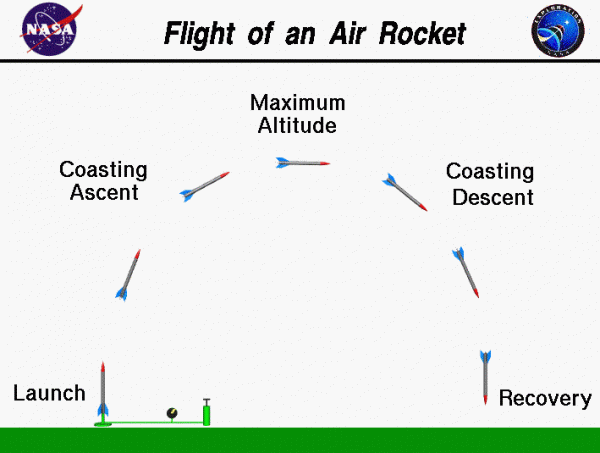Flight of an Air Rocket

Flying Model Rockets
Flying model rockets is a relatively safe and inexpensive way for students to learn the basics of forces and the response of a vehicle to external forces. In flight a model rocket is subjected to four forces; weight, thrust, and the aerodynamic forces, lift and drag. The relative magnitude and direction of the forces determines the flight trajectory of the rocket.
On this page we show the events in the flight of a compressed air rocket. Air rockets are among the simplest type of rocket that a student encounters. The rocket consists of a hollow tube, with a nose cone on one end and stabilizing fins at the other end.
Prior to Launch
A hollow launch tube is inserted into the open end of the rocket. The launch tube is connected to an air pump which pressurizes the inside of the rocket body tube. At launch, the thrust produced by the air pump is greater than the weight of the rocket and the net force accelerates the rocket away from the pad. All of the thrust of an air rocket is expended as the rocket leaves the launch tube.
During the flight, the weight of the rocket is constant and there is no thrust since the air rocket has no engine. The constant weight of an air rocket is very different from full scale rockets or water rockets in which the vehicle weight changes as the propellant is expelled through the nozzle. The lack of thrust is also different from full scale rockets which provide thrust during the entire ascent. Unlike full scale rockets, air rockets rely on aerodynamics for stability. The launch tube provides stability during launch since the low velocity makes the aerodynamic fins ineffective.
Leaving the Pad
The air rocket begins a coasting ascent. The flight of an air rocket is quite similar to the flight of a ballistic shell, or a bullet fired from a gun, except that aerodynamic drag alters the flight of the air rocket. The vehicle slows down under the action of the weight and drag and eventually reaches some maximum altitude which you can measure using some simple length and angle measurements and trigonometry. The rocket then begins to fall back to earth under the power of gravity. Air rockets usually do not include a recovery system like a parachute. After recovering the rocket, you can fly again.
You can study the flight characteristics of an air rocket by using the RocketModeler III simulation program.
On the Graphic
We show the flight path as a large arc through the sky. Ideally, the flight path would be straight up and down; this provides the largest maximum altitude. But air rockets often turn into the wind during flight because of an effect called weathercocking. The effect is the result of aerodynamic forces on the rocket and cause the maximum altitude to be slightly less than the optimum. The parabolic arc trajectory also occurs if the launch platform is tilted, and the rocket is launched at an angle from the vertical.
